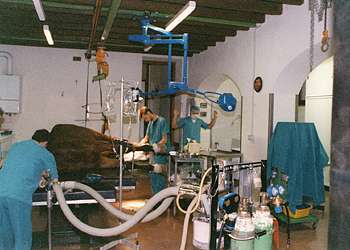REPRODUÇÃO
|
REPRODUÇÃO |
|
|
Laparoscopy
Advances in surgical techniques easier on horses
by Jennifer Lansdowne, Ludovic Bour, Simon Pearce
Cryptorchidism is a developmental defect in both animals and humans that is characterized by failure of one or both testes to descend into the scrotum. Descent of the testes normally occurs in the male fetus. The testes move from within the abdominal cavity through a space called the inguinal canal, to a position outside the body cavity within the scrotum. In male foals, this process is generally completed by two weeks of age. Interruption in this process will result in one or both testis being retained anywhere along its route. Thus the testes may be located inside the abdomen, within the inguinal canal or under the skin in the inguinal (groin) area.

photo: P. da Silva
Retained testicles are not fertile (they do not produce viable sperm), but do produce male hormones (testosterone), causing the cryptorchid horse to have the behavioral characteristics of a stallion. Many veterinarians and breeders believe that chryptorchidism is heritable. This means that a stallion that has one chryptorchid testis and one normal fertile testis can pass on the trait to his offspring. Retained testes have a tendency to become cancerous in horses, and testes that are retained in the inguinal area may be associated with hind limb lameness in some horses. For these reasons, castration of cryptorchid horses is recommended.
A laparotomy is the typical procedure used to castrate cryptorchid stallions. A laparotomy requires general anesthesia and is an invasive surgery, resulting in a large incision in the body wall. In the last six years, laparoscopic cryptorchidectomy has been successfully developed and performed in horses. Laparoscopy has many advantages over laparotomy in the surgical correction of cryptorchidism. Laparoscopy is a less invasive procedure, requiring three or four 1-cm incisions. These small incisions decrease the time required in surgery and in closing the surgical incisions, as well as decrease the time required for the horse to be off exercise while the incision heals.
www.equiworld.net/uk/horsecare/erc/laparoscopy.htm
Courtesy of the Equine Research Centre, Guelph,Ontario
text by Jennifer Lansdowne, Ludovic Bour, Simon Pearce
Department of Clinical Studies, Ontario Veterinary College University of Guelph
© do site "A Cavalo!", proibida a reprodução
total ou parcial de imagens.
Toda e qualquer utilização abusiva destas imagens será penalizada
por todos os meios legais ao alcance dos autores.